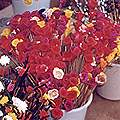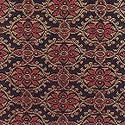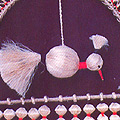The array of dried flowers surrounding Tho Ritse from Nagaland embody a craft form whose hallmark is personal creativity and innovation – flowers, leaves, fruit, berries, grasses and reeds are converted with the help of ideas and dextrous fingers into various dried flower and leaf creations. A big, berry-shaped fruit is cut in half, the inside of both halves scooped out, the outer hollow dried and each half attached to a stick to create two, half-moon shaped floral abstractions. Thin strips of bamboo are cut in the shape of long petals, the petals are arranged by hand into a shape resembling an open flowers, the arranged petals are brought together at the base, wire is twined through them, and they are attached to a stick. Leaves of the Pipal tree (Ficus religiosa) are twisted into the shape of a rosebud and then left to dry till only the delicate vein filigree remains.
There are as many creations and innovative variations as there are craftspersons. This is essentially a craft which relies on imaginative use of the grasses, leaves and fruits found in this densely forested state and on the dexterity of the craftspersons fingers in moulding them into interesting creations; in this sense the term ‘dried flowers’ is an extremely limited definition of this craft which involves much more than merely drying flowers. There are few technical rules pertaining to the craft. One of the few rules that do apply is the commonsense one that the leaves and reeds have to be twisted into the desired shape before they are dried; after they are dry they will be too brittle to be moulded. Colour is also used to make these dried flowers more attractive though now synthetic rather than natural dyes are used.
Both men and women practise this craft; however, it is not even remotely adequate as a livelihood. Neither is the output enough to sustain a livelihood, nor is there any sort of organisation about production, sale and export. In fact, is it perhaps just the personal creativity of individual craftspersons that keeps this ‘craft form’ alive.
Gallery
YOUR VIEWS
PRACTITIONERS: INDIA
Access 70,000+ practitioners in 2500+ crafts across India.
BIBLIOGRAPHY
10,000+ listings on arts, crafts, design, heritage, culture etc.
GLOSSARY
Rich and often unfamiliar vocabulary of crafts and textiles.
SHOP at India InCH
Needs to be written.






